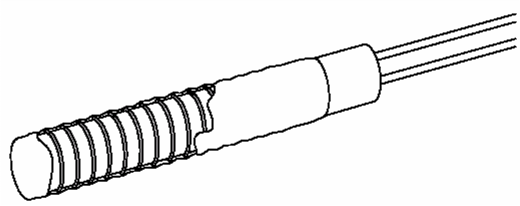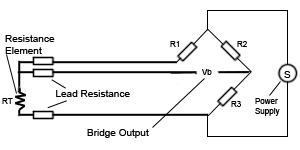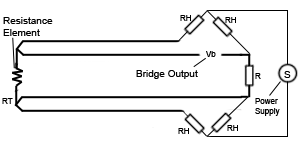Resistance thermometer: Difference between revisions
→Advantages and limitations: - Insert proper line breaks and remove spurious end-of-line spaces |
AlphaTeller (talk | contribs) →External links: fixed links |
||
| Line 516: | Line 516: | ||
== External links == |
== External links == |
||
*[http://www. |
*[http://www.burnsengineering.com Information on RTDs and Calibration] from Burns Engineering |
||
*[http://www.uniteksys.com/Graphics/CalVan.pdf ''The Callendar – van Dusen coefficients''] - How to calculate Callendar – van Dusen coefficients |
*[http://www.uniteksys.com/Graphics/CalVan.pdf ''The Callendar – van Dusen coefficients''] - How to calculate Callendar – van Dusen coefficients |
||
Revision as of 13:19, 18 September 2009
Resistance thermometers, also called resistance temperature detectors or resistive thermal devices (RTDs), are temperature sensors that exploit the predictable change in electrical resistance of some materials with changing temperature. As they are almost invariably made of platinum, they are often called platinum resistance thermometers (PRTs). They are slowly replacing the use of thermocouples in many industrial applications below 600 °C, due to higher accuracy and repeatability.
General description
There are two broad categories, "film" and "wire-wound" types.
- Film thermometers have a layer of platinum on a substrate; the layer may be extremely thin, perhaps one micrometer. Advantages of this type are relatively low cost and fast response. Such devices have improved in performance although the different expansion rates of the substrate and platinum give "strain gauge" effects and stability problems.
- Wire-wound thermometers can have greater accuracy, especially for wide temperature ranges. The coil diameter provides a compromise between mechanical stability and allowing expansion of the wire to minimize strain and consequential drift.
- Coil Elements have largely replaced wire wound elements in the industry. This design allows the wire coil to expand more freely over temperature while still provided the necessary support for the coil. This design is similar to that of a SPRT, the primary standard which ITS-90 is based on, while still providing the durability necessary for an industrial process.
The current international standard which specifies tolerance and the temperature to electrical resistance relationship for platinum resistance thermometers is IEC 751:1983. By far the most common devices used in industry have a nominal resistance of 100 ohms at 0 °C, and are called Pt-100 sensors ('Pt' is the symbol for platinum). The sensitivity of a standard 100 ohm sensor is a nominal 0.385 ohm/°C. RTDs with a sensitivity of 0.375 and 0.392 ohm/°C as well as a variety of others are also available.
Function
Resistance thermometers are constructed in a number of forms and offer greater stability, accuracy and repeatability in some cases than thermocouples. While thermocouples use the Seebeck effect to generate a voltage, resistance thermometers use electrical resistance and require a power source to operate. The resistance ideally varies linearly with temperature.
Resistance thermometers are usually made using platinum, because of its linear resistance-temperature relationship and its chemical inertness. The platinum detecting wire needs to be kept free of contamination to remain stable. A platinum wire or film is supported on a former in such a way that it gets minimal differential expansion or other strains from its former, yet is reasonably resistant to vibration. RTD assemblies made from iron or copper are also used in some applications.
Commercial platinum grades are produced which exhibit a change of resistance of 0.385 ohms/°C (European Fundamental Interval) The sensor is usually made to have a resistance of 100Ω at 0 °C. This is defined in BS EN 60751:1996 (taken from IEC 60751:1995) . The American Fundamental Interval is 0.392 Ω/°C, based on using a purer grade of platinum than the European standard. The American standard is from the Scientific Apparatus Manufacturers Association (SAMA), who are no longer in this standards field. As a result the "American standard" is hardly the standard even in the US.
Resistance thermometers require a small current to be passed through in order to determine the resistance. This can cause resistive heating, and manufacturers' limits should always be followed along with heat path considerations in design. Care should also be taken to avoid any strains on the resistance thermometer in its application. Lead wire resistance should be considered, and adopting three and four wire connections can eliminate connection lead resistance effects from measurements - industrial practice is almost universally to use 3-wire connection. 4-wire connections need to be used for precise applications.
Advantages and limitations
Advantages of platinum resistance thermometers:
- High accuracy
- Low drift
- Wide operating range
- Suitability for precision applications
Limitations:
- RTDs in industrial applications are rarely used above 660 °C. At temperatures above 660 °C it becomes increasingly difficult to prevent the platinum from becoming contaminated by impurities from the metal sheath of the thermometer. This is why laboratory standard thermometers replace the metal sheath with a glass construction. At very low temperatures, say below -270 °C (or 3 K), due to the fact that there are very few phonons, the resistance of an RTD is mainly determined by impurities and boundary scattering and thus basically independent of temperature. As a result, the sensitivity of the RTD is essentially zero and therefore not useful.
- Compared to thermistors, platinum RTDs are less sensitive to small temperature changes and have a slower response time. However thermistors have a smaller temperature range and stability.
Common Error Sources:
The common error sources of a PRT are:
- Insulation Resistance: Error caused by the inability to measure the actual resistance of element. Current leaks into or out of the circuit through the sheath, between the element leads, or the elements.
- Stability: Ability to maintain R vs T over time as a result of thermal exposure.
- Repeatability: Ability to maintain R vs T under the same conditions after experiencing thermal cycling throughout a specified temperature range.
- Hysteresis: Change in the characteristics of the materials from which the RTD is built due to exposures to varying temperatures.
- Stem Conduction: Error that results from the PRT sheath conducting heat into or out of the process.
- Calibration/Interpolation: Errors that occur due to calibration uncertainty at the cal points, or between cal point due to propagation of uncertainty or curve fit errors.
- Lead Wire: Errors that occur because a 4 wire or 3 wire measurement is not used, this is greatly increased by higher gauge wire.
- 2 wire connection adds lead resistance in series with PRT element.
- 3 wire connection relies on all 3 leads having equal resistance.
- Self Heating: Error produced by the heating of the PRT element due to the power applied.
- Time Response: Errors are produced during temperature transients because the PRT cannot respond to changes fast enough.
- Thermal EMF: Thermal EMF errors are produced by the EMF adding to or subtracting from the applied sensing voltage, primarily in DC systems.
When to use RTDs or thermocouples
The two most common ways of measuring industrial temperatures are with resistance temperature detectors (RTDs) and thermocouples. But when should control engineers use a thermocouple and when should they use an RTD? The answer is usually determined by four factors: Factors: - Temperature, time, size, and overall accuracy requirements.
- What are the temperature requirements? Thermocouples have a range of -180 °C to 1300 °C (-300 to 2300 °F),[citation needed] so for extremely high temperatures they are the only contact temperature measurement choice.
- What are the time-response requirements? If the process requires a very fast response to temperature changes—fractions of a second as opposed to seconds (i.e. 2.5 to 10 s)—then a thermocouple is the best choice. Keep in mind that time response is measured by immersing the sensor in water moving at 1 m/s (3 ft/s) with a 63.2% step change.
- What are the size requirements? A standard RTD sheath is 3.175 to 6.35 mm (0.125 to 0.25 in.) in diameter, while sheath diameters for thermocouples can be less than 1.6 mm (0.062 in.).
- What are the overall requirements for accuracy? If the process only requires a tolerance of 2 °C or greater, then a thermocouple is appropriate. If the process needs less than 2 °C tolerance, then an RTD is sometimes the only choice.
Elements
Resistance thermometer elements are available in a number of forms. The most common are:
- Unsupported Wire wound - a wire coil minimally supported within a sealed housing and backfilled with an inert gas. These sensors work up to 961.78 °C and are used in the SPRT’s that define ITS-90
- Wire wound in a ceramic insulator – a wire coil sealed in a ceramic cylinder, works with temperatures to 850 °C
- Wire encapsulated in glass - wire around glass core with glass fused homogenously around, resists vibration, more protection to the detecting wire but smaller usable range
- Thin film - platinum film on ceramic substrate, small and inexpensive to mass produce, fast response to temperature change but smaller temperature range and lower accuracy.
Construction
These elements nearly always require insulated leads attached. At low temperatures PVC, silicon rubber or PTFE insulators are common to 250°C. Above this, glass fibre or ceramic are used. The measuring point and usually most of the leads require a housing or protection sleeve. This is often a metal alloy which is inert to a particular process. Often more consideration goes in to selecting and designing protection sheaths than sensors as this is the layer that must withstand chemical or physical attack and offer convenient process attachment points.
Wiring configurations
Two-wire configuration
The simplest resistance thermometer configuration uses two wires. It is only used when high accuracy is not required as the resistance of the connecting wires is always included with that of the sensor leading to errors in the signal. Using this configuration you will be able to use 100 meters of cable. This applies equally to balanced bridge and fixed bridge system.
Three-wire configuration
In order to minimize the effects of the lead resistances a three wire configuration can be used. Using this method the two leads to the sensor are on adjoining arms, there is a lead resistance in each arm of the bridge and therefore the lead resistance is cancelled out. High quality connection cables should be used for this type of configuration because an assumption is made that the two lead resistances are the same. This configuration allows for up to 600 meters of cable.
Four-wire configuration
The four wire resistance thermometer configuration even further increases the accuracy and reliability of the resistance being measured. In the diagram above a standard two terminal RTD is used with another pair of wires to form an additional loop that cancels out the lead resistance. The above Wheatstone bridge method uses a little more copper wire and is not a perfect solution. Below is a better alternative configuration four-wire Kelvin connection that should be used in all RTDs. It provides full cancellation of spurious effects and cable resistance of up to 15 Ω can be handled. Actually in four wire measurement the resistance error due to lead wire resistance is zero.
History
The application of the tendency of electrical conductors to increase their electrical resistance with rising temperature was first described by Sir William Siemens at the Bakerian Lecture of 1871 before the Royal Society of Great Britain. The necessary methods of construction were established by Callendar, Griffiths, Holborn and Wein between 1885 and 1900.
Standard resistance thermometer data
Temperature sensors are usually supplied with thin-film elements. The resisting elements are rated in accordance with BS EN 60751:2008 as:
| Tolerance Class | Valid Range |
|---|---|
| Tolerance class F 0.3 | -50 to +500 °C |
| Tolerance class F 0.15 | -30 to +300 °C |
| Tolerance class F 0.1 | 0 to +150 °C |
Resistance thermometer elements can be supplied which function up to 1000 °C. The relation between temperature and resistance is given by the Callendar-Van Dusen equation,
Here, is the resistance at temperature T, is the resistance at 0 °C, and the constants (for an alpha=0.00385 platinum RTD) are
Since the B and C coefficients are relatively small, the resistance changes almost linearly with the temperature.
Values for various popular resistance thermometers
| Temperature in °C |
Pt100 in Ω |
Pt1000 in Ω |
PTC in Ω |
NTC in Ω |
NTC in Ω |
NTC in Ω |
NTC in Ω |
NTC in Ω |
| Typ: 404 | Typ: 501 | Typ: 201 | Typ: 101 | Typ: 102 | Typ: 103 | Typ: 104 | Typ: 105 | |
| −50 | 80,31 | 803,1 | 1032 | |||||
| −45 | 82,29 | 822,9 | 1084 | |||||
| −40 | 84,27 | 842,7 | 1135 | 50475 | ||||
| −35 | 86,25 | 862,5 | 1191 | 36405 | ||||
| −30 | 88,22 | 882,2 | 1246 | 26550 | ||||
| −25 | 90,19 | 901,9 | 1306 | 26083 | 19560 | |||
| −20 | 92,16 | 921,6 | 1366 | 19414 | 14560 | |||
| −15 | 94,12 | 941,2 | 1430 | 14596 | 10943 | |||
| −10 | 96,09 | 960,9 | 1493 | 11066 | 8299 | |||
| −5 | 98,04 | 980,4 | 1561 | 31389 | 8466 | |||
| 0 | 100,00 | 1000,0 | 1628 | 23868 | 6536 | |||
| 5 | 101,95 | 1019,5 | 1700 | 18299 | 5078 | |||
| 10 | 103,90 | 1039,0 | 1771 | 14130 | 3986 | |||
| 15 | 105,85 | 1058,5 | 1847 | 10998 | ||||
| 20 | 107,79 | 1077,9 | 1922 | 8618 | ||||
| 25 | 109,73 | 1097,3 | 2000 | 6800 | 15000 | |||
| 30 | 111,67 | 1116,7 | 2080 | 5401 | 11933 | |||
| 35 | 113,61 | 1136,1 | 2162 | 4317 | 9522 | |||
| 40 | 115,54 | 1155,4 | 2244 | 3471 | 7657 | |||
| 45 | 117,47 | 1174,7 | 2330 | 6194 | ||||
| 50 | 119,40 | 1194,0 | 2415 | 5039 | ||||
| 55 | 121,32 | 1213,2 | 2505 | 4299 | 27475 | |||
| 60 | 123,24 | 1232,4 | 2595 | 3756 | 22590 | |||
| 65 | 125,16 | 1251,6 | 2689 | 18668 | ||||
| 70 | 127,07 | 1270,7 | 2782 | 15052 | ||||
| 75 | 128,98 | 1289,8 | 2880 | 12932 | ||||
| 80 | 130,89 | 1308,9 | 2977 | 10837 | ||||
| 85 | 132,80 | 1328,0 | 3079 | 9121 | ||||
| 90 | 134,70 | 1347,0 | 3180 | 7708 | ||||
| 95 | 136,60 | 1366,0 | 3285 | 6539 | ||||
| 100 | 138,50 | 1385,0 | 3390 | |||||
| 105 | 140,39 | 1403,9 | ||||||
| 110 | 142,29 | 1422,9 | ||||||
| 150 | 157,31 | 1573,1 | ||||||
| 200 | 175,84 | 1758,4 |
See also
References
Text and images used by permission of Peak Sensors Ltd: Platinum Resistance Thermometer Information
External links
- Information on RTDs and Calibration from Burns Engineering
- The Callendar – van Dusen coefficients - How to calculate Callendar – van Dusen coefficients









![{\displaystyle R_{T}=R_{0}\left[1+AT+BT^{2}+CT^{3}(T-100)\right]\;(-200\;{}^{\circ }\mathrm {C} <T<0\;{}^{\circ }\mathrm {C} ),}](https://wikimedia.org/api/rest_v1/media/math/render/svg/4a95892015229c5410f0f93dad9e86daa5bfbca8)
![{\displaystyle R_{T}=R_{0}\left[1+AT+BT^{2}\right]\;(0\;{}^{\circ }\mathrm {C} \leq T<850\;{}^{\circ }\mathrm {C} ).}](https://wikimedia.org/api/rest_v1/media/math/render/svg/c2dee8f5b1c906719f57def2cb23185fcb50620e)




